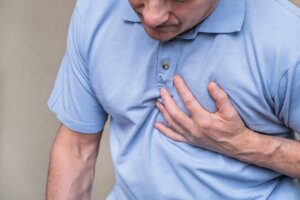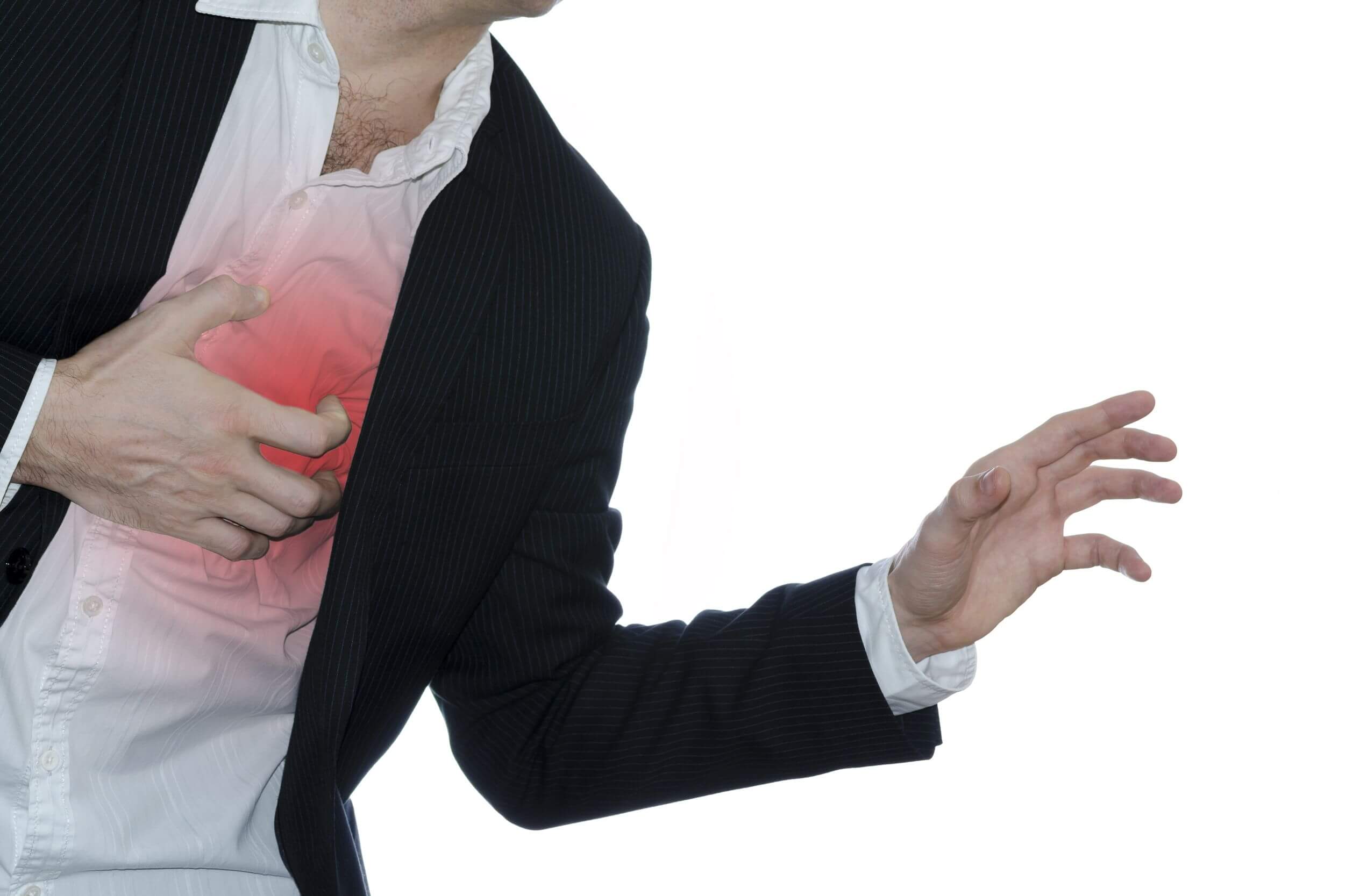How to Deal with a Heart Attack

A heart attack, or to give it its medical name, an acute myocardial infarction, is one of the most feared heart situations of all due to the large number of deaths it creates. It’s known as the silent killer, as it can occur at any time and bring deadly consequences if not treated in time. In this sense, it’s essential that everyone knows what to do in this situation.
Heart attacks occur when a portion of the heart doesn’t receive an adequate blood supply. This situation appears after the obstruction of the coronary arteries and usually worsens as time passes. In this sense, multiple studies affirm that timely medical care is capable of reducing mortality in many cases.
What to do when there’s a heart attack
The first thing people in this situation should do is stay calm. Nerves can be the worst enemy of both the person who has suffered the heart attack and the person who wants to help.
The most important thing is to pay attention to the symptoms to confirm the presence of a heart attack. The main symptom of this condition is oppressive pain at the retrosternal level. It can spread to other areas such as the left arm, neck, and jaw. The duration of this pain is greater than 15 minutes and doesn’t subside with rest.
In addition to the angina pectoris described, people may experience shortness of breath, profuse sweating, nausea, vomiting, and weakness. First aid should begin a few minutes after the appearance of symptoms, so it’s necessary to carry out the following recommendations:
1. Call the local emergency service

Not knowing how to deal with a heart attack can be overwhelming for many. However, the first thing to do is call your local emergency service. This is because people suffering from a heart attack must receive specialized medical attention as soon as possible to avoid severe damage to the heart muscle.
Everyone should know the specific emergency services number in the area they live in. If it’s impossible to make the call, then take the person to the nearest health center immediately.
When answering the call, the emergency personnel will ask for specific information, which must be answered accurately. They can also provide instructions, which must be fully followed to improve the patient’s general condition.
2. Reassure the affected person
A pain in the chest can be very unpleasant and will make the person feel very agitated. However, both nerves and agitation increase the heart rate, which worsens the condition of myocardial cells and the pain.
Those accompanying the patient should try and calm them down. A good idea is to ask them to take a seat, breathe slowly, and avoid straining. This is the ideal time to ask if the person is taking any medication for a heart condition.
Some people recommend taking aspirin or a blood thinner while waiting for medical attention. However, this can have negative consequences, so no drug should be administered without a prescription.
A person suffering from a heart attack should remove all tight clothing. In this way, they’ll feel more comfortable despite the pain. In addition, being in a ventilated and cool environment can be useful.
3. Start CPR if necessary
Cardiopulmonary resuscitation (CPR) is a technique used in cases of cardiac arrest. In out-of-hospital emergency conditions, CPR can be initiated by people who don’t work in the health area but who have been properly trained. It seeks to maintain adequate blood flow in the body and reactivate the heart to perform its pumping function.
Multiple studies affirm that the correct application of CPR considerably increases the degree of survival of patients. A specific cycle of 2 inflations for every 30 cardiac compressions should be maintained. Cardiac compressions should be carried out at a rate of at least 100 compressions per minute.
Not all people who suffer from a heart attack need CPR, so the general condition of the affected person should be checked before acting. CPR should only be started when the affected person meets all of the following conditions:
- They’re unconscious
- There’s no palpable pulse in the wrist or neck
- No respiratory movements are observed in the rib cage
- They don’t have active bleeding
The technique used is essential to avoid damage during the application of the maneuver. People should call the emergency service for precise instructions if they don’t have the necessary knowledge or have never applied CPR. The personnel in question are trained to guide any individual in these types of situations.
4. Don’t leave the affected person alone at any time
The condition of a person having a heart attack can change quickly. Because of this, it’s necessary to stay by the affected person’s side at all times until medical attention is received. The companions must inform the emergency service immediately if there’s any sudden change in the symptoms, such as loss of consciousness.
Medical treatment of heart attack

At present, doctors have multiple clinical action guidelines, which show how to deal with a heart attack in the hospital center. They have precise and similar instructions that are adapted to each particular case. Generally speaking, treatment is aimed at restoring blood circulation as soon as possible.
Doctors have a large variety of medications, which help dissolve the thrombus and improve the blood supply to the heart. Thus, the administration of anticoagulant and antiplatelet drugs is the first option in most cases.
The use of vasodilators is also recommended as it improves blood circulation in the short term. In this sense, specialists usually administer drugs such as nitroglycerin, beta receptor antagonists, and some antihypertensive drugs. Certain compounds such as morphine are also used to reduce pain.
It’s very important to constantly monitor people who have had/are having a heart attack, as well as carrying out all the corresponding tests. In this way, doctors can clearly establish the seriousness of the situation. This fact will also help them to know if they should start surgical treatment or not.
Knowing how to act in the event of a heart attack is essential
Heart attacks are unexpected situations that can occur at any time. They can seriously worsen the affected person’s state of health in a short time, so it’s necessary to act promptly and appropriately. One of the most important steps is to remain calm and reassure the person suffering from the heart attack.
It goes without saying that the local emergency services should be advised as soon as possible. They usually keep the call active until the arrival of the ambulance. They’re also likely to ask questions about the event and provide instructions for performing CPR if necessary.
Timely medical care improves the outlook for all heart attack sufferers. In this sense, it’s necessary to transfer the affected person to a health center as soon as possible so that they receive adequate care.
A heart attack, or to give it its medical name, an acute myocardial infarction, is one of the most feared heart situations of all due to the large number of deaths it creates. It’s known as the silent killer, as it can occur at any time and bring deadly consequences if not treated in time. In this sense, it’s essential that everyone knows what to do in this situation.
Heart attacks occur when a portion of the heart doesn’t receive an adequate blood supply. This situation appears after the obstruction of the coronary arteries and usually worsens as time passes. In this sense, multiple studies affirm that timely medical care is capable of reducing mortality in many cases.
What to do when there’s a heart attack
The first thing people in this situation should do is stay calm. Nerves can be the worst enemy of both the person who has suffered the heart attack and the person who wants to help.
The most important thing is to pay attention to the symptoms to confirm the presence of a heart attack. The main symptom of this condition is oppressive pain at the retrosternal level. It can spread to other areas such as the left arm, neck, and jaw. The duration of this pain is greater than 15 minutes and doesn’t subside with rest.
In addition to the angina pectoris described, people may experience shortness of breath, profuse sweating, nausea, vomiting, and weakness. First aid should begin a few minutes after the appearance of symptoms, so it’s necessary to carry out the following recommendations:
1. Call the local emergency service

Not knowing how to deal with a heart attack can be overwhelming for many. However, the first thing to do is call your local emergency service. This is because people suffering from a heart attack must receive specialized medical attention as soon as possible to avoid severe damage to the heart muscle.
Everyone should know the specific emergency services number in the area they live in. If it’s impossible to make the call, then take the person to the nearest health center immediately.
When answering the call, the emergency personnel will ask for specific information, which must be answered accurately. They can also provide instructions, which must be fully followed to improve the patient’s general condition.
2. Reassure the affected person
A pain in the chest can be very unpleasant and will make the person feel very agitated. However, both nerves and agitation increase the heart rate, which worsens the condition of myocardial cells and the pain.
Those accompanying the patient should try and calm them down. A good idea is to ask them to take a seat, breathe slowly, and avoid straining. This is the ideal time to ask if the person is taking any medication for a heart condition.
Some people recommend taking aspirin or a blood thinner while waiting for medical attention. However, this can have negative consequences, so no drug should be administered without a prescription.
A person suffering from a heart attack should remove all tight clothing. In this way, they’ll feel more comfortable despite the pain. In addition, being in a ventilated and cool environment can be useful.
3. Start CPR if necessary
Cardiopulmonary resuscitation (CPR) is a technique used in cases of cardiac arrest. In out-of-hospital emergency conditions, CPR can be initiated by people who don’t work in the health area but who have been properly trained. It seeks to maintain adequate blood flow in the body and reactivate the heart to perform its pumping function.
Multiple studies affirm that the correct application of CPR considerably increases the degree of survival of patients. A specific cycle of 2 inflations for every 30 cardiac compressions should be maintained. Cardiac compressions should be carried out at a rate of at least 100 compressions per minute.
Not all people who suffer from a heart attack need CPR, so the general condition of the affected person should be checked before acting. CPR should only be started when the affected person meets all of the following conditions:
- They’re unconscious
- There’s no palpable pulse in the wrist or neck
- No respiratory movements are observed in the rib cage
- They don’t have active bleeding
The technique used is essential to avoid damage during the application of the maneuver. People should call the emergency service for precise instructions if they don’t have the necessary knowledge or have never applied CPR. The personnel in question are trained to guide any individual in these types of situations.
4. Don’t leave the affected person alone at any time
The condition of a person having a heart attack can change quickly. Because of this, it’s necessary to stay by the affected person’s side at all times until medical attention is received. The companions must inform the emergency service immediately if there’s any sudden change in the symptoms, such as loss of consciousness.
Medical treatment of heart attack

At present, doctors have multiple clinical action guidelines, which show how to deal with a heart attack in the hospital center. They have precise and similar instructions that are adapted to each particular case. Generally speaking, treatment is aimed at restoring blood circulation as soon as possible.
Doctors have a large variety of medications, which help dissolve the thrombus and improve the blood supply to the heart. Thus, the administration of anticoagulant and antiplatelet drugs is the first option in most cases.
The use of vasodilators is also recommended as it improves blood circulation in the short term. In this sense, specialists usually administer drugs such as nitroglycerin, beta receptor antagonists, and some antihypertensive drugs. Certain compounds such as morphine are also used to reduce pain.
It’s very important to constantly monitor people who have had/are having a heart attack, as well as carrying out all the corresponding tests. In this way, doctors can clearly establish the seriousness of the situation. This fact will also help them to know if they should start surgical treatment or not.
Knowing how to act in the event of a heart attack is essential
Heart attacks are unexpected situations that can occur at any time. They can seriously worsen the affected person’s state of health in a short time, so it’s necessary to act promptly and appropriately. One of the most important steps is to remain calm and reassure the person suffering from the heart attack.
It goes without saying that the local emergency services should be advised as soon as possible. They usually keep the call active until the arrival of the ambulance. They’re also likely to ask questions about the event and provide instructions for performing CPR if necessary.
Timely medical care improves the outlook for all heart attack sufferers. In this sense, it’s necessary to transfer the affected person to a health center as soon as possible so that they receive adequate care.
- Fang J, Luncheon C, Ayala C, Odom E et al. Awareness of Heart Attack Symptoms and Response Among Adults – United States, 2008, 2014, and 2017. MMWR Morb Mortal Wkly Rep. 2019 Feb 8;68(5):101-106.
- Ong EH. Improving the quality of CPR in the community. Singapore Med J. 2011 Aug;52(8):586-91.
- Ibanez B, James S, Agewall S, Antunes M, Bucciarelli-Ducci C, Bueno H et al. 2017 ESC Guidelines for the management of acute myocardial infarction in patients presenting with ST-segment elevation. European Heart Journal. 2017;39(2):119-177.
- Hand MM. Act in time to heart attack signs: update on the National Heart Attack Alert Program’s campaign to reduce patient delay. Crit Pathw Cardiol. 2004 Sep;3(3):128-33.
- Lu L, Liu M, Sun R, Zheng Y, Zhang P. Myocardial Infarction: Symptoms and Treatments. Cell Biochem Biophys. 2015 Jul;72(3):865-7.
- Eichner ER. Never Take Your Heart by Surprise: Heart Attack Triggers. Curr Sports Med Rep. 2016 Mar-Apr;15(2):65-6.
Este texto se ofrece únicamente con propósitos informativos y no reemplaza la consulta con un profesional. Ante dudas, consulta a tu especialista.







